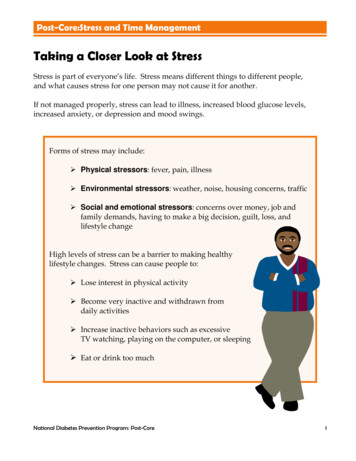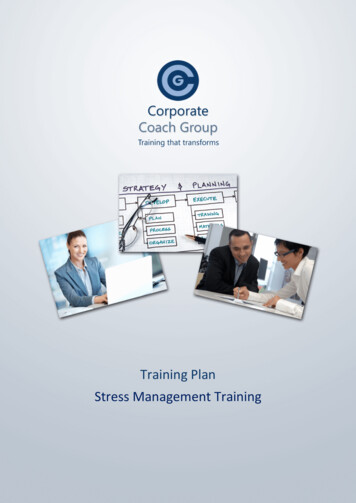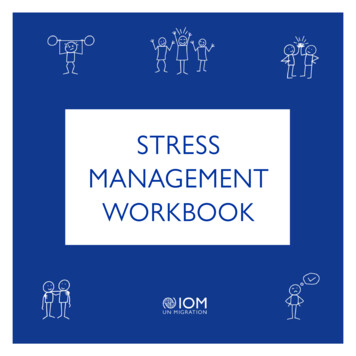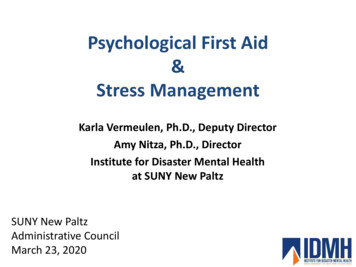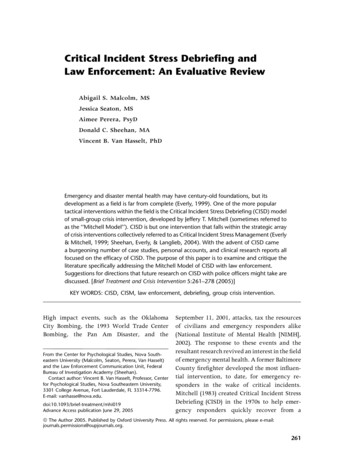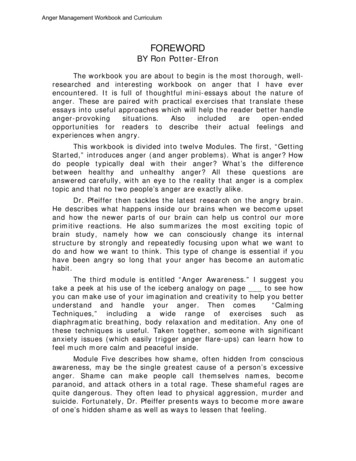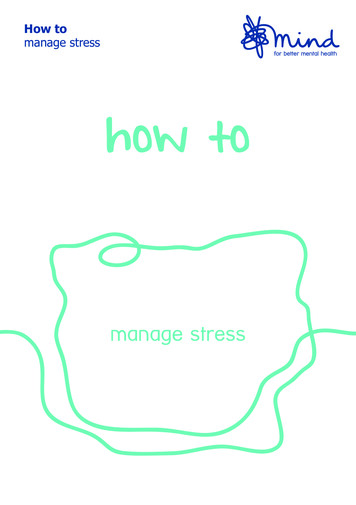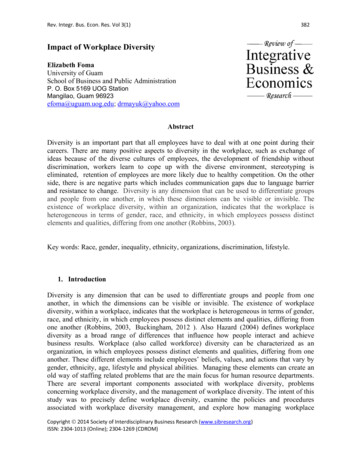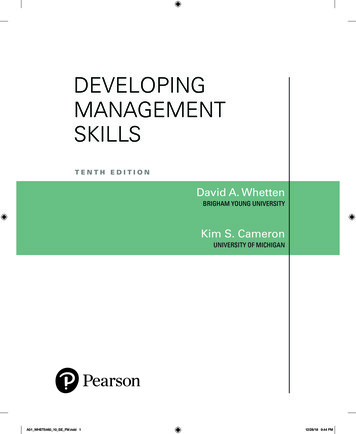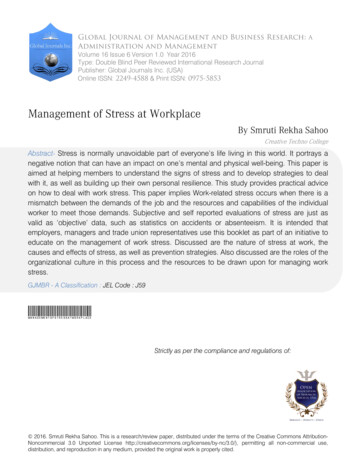
Transcription
Global Journal of Management and Business Research: AAdministration and ManagementVolume 16 Issue 6 Version 1.0 Year 2016Type: Double Blind Peer Reviewed International Research JournalPublisher: Global Journals Inc. (USA)Online ISSN: 2249-4588 & Print ISSN: 0975-5853Management of Stress at WorkplaceBy Smruti Rekha SahooCreative Techno CollegeAbstract- Stress is normally unavoidable part of everyone’s life living in this world. It portrays anegative notion that can have an impact on one’s mental and physical well-being. This paper isaimed at helping members to understand the signs of stress and to develop strategies to dealwith it, as well as building up their own personal resilience. This study provides practical adviceon how to deal with work stress. This paper implies Work-related stress occurs when there is amismatch between the demands of the job and the resources and capabilities of the individualworker to meet those demands. Subjective and self reported evaluations of stress are just asvalid as ‘objective’ data, such as statistics on accidents or absenteeism. It is intended thatemployers, managers and trade union representatives use this booklet as part of an initiative toeducate on the management of work stress. Discussed are the nature of stress at work, thecauses and effects of stress, as well as prevention strategies. Also discussed are the roles of theorganizational culture in this process and the resources to be drawn upon for managing workstress.GJMBR - A Classification : JEL Code : J59ManagementofStressatWorkplaceStrictly as per the compliance and regulations of: 2016. Smruti Rekha Sahoo. This is a research/review paper, distributed under the terms of the Creative Commons AttributionNoncommercial 3.0 Unported License http://creativecommons.org/licenses/by-nc/3.0/), permitting all non-commercial use,distribution, and reproduction in any medium, provided the original work is properly cited.
Management of Stress at Workplace“SI.Introductionuccessful employers and managers provideleadership in dealing with the challenge ofwork stress”.Stress is a state of mind or an illness. Stress isthe way human beings react both physically andmentally to changes, events, and in their lives. Anotherword for stress is tension or anxiety. ’Stress occurswhere demands made on individuals do not match theresources available or meet the individual’s needs andmotivation stress will be the result if the workload istoo large for the number of workers and time available.When someone experiences stress, there are manydifferent symptoms and repercussion. Depending on thelevel and frequency of stress, some of these symptomscan become serious and cause a many of problems.Stress affects people both mentally and physically. Theheart rate increases, headaches can develop, and oftenpeople become irritated much more easily. Individualswho work in high stress or dangerous jobs as well asthose who are employed at a place where there is a highpressure environment are often prone to experiencingstress. Work environment, coworker relations, andcustomer pressures can all contribute to stress at work.Understanding how to manage, minimize, and deal withstress can help people feel more relaxed and reactwhen stressful situations as they arise. Peopleexperience stress in different ways and for differentreasons. The reaction is based on your perception of anevent or situation. The adverse reaction people have toAuthor: Creative Techno College. e-mail: smrutirekha001@gmail.comII.Difference between Pressure &TensionPressure it what can puts you in stress but notall the time and mostly comes from external behaviorsas having overload of tasks, Manager need you foralternative tasks, someone your supports and so on. 2016 Global Journals Inc. (US)Yearexcessive pressures or other types of demand placedon them. Workers who are stressed are also more likelyto be unhealthy, poorly motivated, less productive andless safe at work. Their organizations are less likely to besuccessful in a competitive market. Employers cannotusually protect workers from stress arising outside ofwork, but they can protect them from stress that arisesthrough work. Stress at work can be a real problem tothe organization as well as for its workers. While youcan’t avoid stress, you can learn to manage it anddevelop skills to cope with the events or situations youfind stressful. Good management and good workorganization are the best forms of stress prevention [8].If employees are already stressed, their managersshould be aware of it and know how to help.Organizational culture is one of the key factorsin determining how successful an organization will be inmanaging work stress. Organizational culture isreflected in the attitudes of staff, their shared beliefsabout the organization, their shared value systems andcommon and approved ways of behaving at work [2].Organizational culture also concerns howproblems are predictable and solved. It can affect whatis experienced as stressful, how that experiencetranslates into health difficulties, how both stress andhealth are reported and how the organization respondsto such reports.Employers, managers and trade unionrepresentatives must therefore become aware of theculture of an organization, and explore it in relation tothe management of work stress. If necessary, theseparties must engage in culture change activities as animportant aspect of improving the management ofstress at work.Work related stress is the response people mayhave when presented with work demands and pressuresthat are not matched to their knowledge and abilitiesand which challenge their ability to cope. Stress occursin a wide range of work circumstances but is often madeworse when employees feel they have little support fromsupervisors and colleagues and where they have littlecontrol over work or how they can cope with itsdemands and pressures.1Global Journal of Management and Business Research ( A ) Volume XVI Issue VI Version IAbstract- Stress is normally unavoidable part of everyone’s lifeliving in this world. It portrays a negative notion that can havean impact on one’s mental and physical well-being. This paperis aimed at helping members to understand the signs of stressand to develop strategies to deal with it, as well as building uptheir own personal resilience. This study provides practicaladvice on how to deal with work stress. This paper impliesWork-related stress occurs when there is a mismatch betweenthe demands of the job and the resources and capabilities ofthe individual worker to meet those demands. Subjective andself reported evaluations of stress are just as valid as‘objective’ data, such as statistics on accidents orabsenteeism. It is intended that employers, managers andtrade union representatives use this booklet as part of aninitiative to educate on the management of work stress.Discussed are the nature of stress at work, the causes andeffects of stress, as well as prevention strategies. Alsodiscussed are the roles of the organizational culture in thisprocess and the resources to be drawn upon for managingwork stress.2016Smruti Rekha Sahoo
Management of Stress at WorkplaceYear2016Stress it can be pressure converted to stressand it’s what you deal with internally that effects yourfeelings as dis motivation, no one care about your tasks,no one support you, no time management, be nervous,someone make you mad and so on.Pressure is being overloaded or having a timedeadline accompanied with lots of work.Stress is that negative energy that controls youand convinces you that you aren't going to achieve yourwork within that deadline you have.The main causes of work related pressure andstress wereGlobal Journal of Management and Business Research ( A ) Volume XVI Issue VI Version I2 Lack of management supportWork related violence and harassmentIII.Model of Work StressThe Health and Safety Executive (HSE) definesstress as an [5] [10] ‘adverse reaction people have toexcessive pressures or other types of demand placedon them’. Work-related stress is thus understood tooccur when there is a mismatch between the demandsof the job and the resources and capabilities of theindividual worker to meet those demands. This definitionemphasizes the relationship between individuals andtheir working environment, and helps to explain why asituation that one person regards as a stimulatingchallenge causes another to experience a damagingdegree of stress. A recent report by the NationalAssociation of Mental Health confirms that the individualworker’s ‘personality and coping strategy’ can havedirect, moderating or perceptual effects on stressoutcomes. For example, an extroverted person mightfind a socially isolating job more stressful than anintroverted person, who conversely, might find a job withgreater levels of social interaction more difficult andstressful. Moreover, a worker’s past experience,individual characteristics and personal resourcesappear to influence how she or he interprets andmanages the specific conditions and demands of thejob. The National Association of Mental Health reportalso draws an major distinction between stress andpressure. Pressure is defined as a subjective feeling oftension or arousal that is triggered by a potentiallystressful situation. Because it stimulates mentalalertness and motivation, pressure may have a positiveimpact on employee performance and satisfaction.However, when this pressure becomes extreme,persistent and unrelieved, it may lead to irritability, fear,frustration, aggression and stress, and may evencontribute to a variety of short or long term physical andmental illnesses. When pressure exceeds an individual’sability to cope, the result is stress.HSE has identified six categories of potentialstressors mentioned in fig-1. It should be noted that inthis model a further, seventh driver of stress is identifiedculture which is not identified as an explicit stressor by 2 0161 Global Journals Inc. (US)the HSE but which Palmer et al describe as ‘the cultureof the organization and how it approaches andmanages work-related stress when it arises’.[4]a) DemandsThis includes factors intrinsic to the job such asworking conditions (for example noise, temperature,lighting or ventilation), shift work, long or unsociablehours, workload.b) ControlHow much say and autonomy a person hasover the way in which he carries out his job; low levels ofjob control are typically linked to high levels of stress.c) RelationshipsRelationships with superiors, subordinates andcolleagues can all play a part in an individual’s stresslevels; low levels of trust and support are likely toincrease stress. Also, conflict, harassment and bullyingin the workplace are all linked to heightened stress.d) ChangeThe way in which change is introduced,managed and communicated to staff can impact onlevels of stress, as unnecessary or badly plannedchange results in excess pressure on workers.e) RoleStress may be triggered when an individualdoes not have a clear understanding of his role withinthe organization, when there is conflict between roles orambiguity with regards to position and degree ofresponsibility over others.f)SupportThe amount of support and job trainingavailable, as well as encouragement, sponsorship andresources provided by colleagues and management.
Year2016Management of Stress at Workplace Palmer & Cooper 2001Fig.1 : [Model of Work Stress]IV.Causes of Work StressExcessiveandotherwiseuncontrollabledemands and pressures can be caused by poor workdesign, poor management and unsatisfactory workingconditions. Similarly, these things can result in workersnot receiving sufficient support from others or not havingenough control over their work and its pressures. Mostof the causes of work stress concern the way work isdesigned and the way in which organizations aremanaged. Because these aspects of work have thepotential for causing harm, they are called ‘stressrelated hazards’ [9]. The literature on stress generallyrecognizes nine categories of stress-related hazardsand that are listed below:a) Job Content Tedious, under-stimulating, meaningless tasksLack of varietyUnpleasant tasksb) Workload and Work Place Having too much or too little to do Working under time pressuresc) Working HoursStrict and inflexible working schedulesLong and unsocial hoursUnpredictable working hours 2016 Global Journals Inc. (US)Global Journal of Management and Business Research ( A ) Volume XVI Issue VI Version I3
Management of Stress at WorkplaceYear2016d) Participation and Control Lack of participation in decision making Lack of control (for example, over work methods,work pace, working hours and the workenvironment)Global Journal of Management and Business Research ( A ) Volume XVI Issue VI Version I4e) Career Development, Status and PayJob insecurityLack of promotion prospectsUnder-promotion or over-promotionUnclear or unfair performance evaluation systemsBeing over-skilled or under-skilled for the jobf) Role in the OrganizationUnclear roleConflicting roles within the same jobResponsibility for peopleContinuously dealing with other people and theirproblemsg) Interpersonal Relationships Inadequate,inconsiderateorunsupportivesupervision Poor relationships with co-workers Harassment and violence Isolated or solitary work No agreed procedures for dealing with problems orcomplaintsh) Organizational Culture Poor communication Poor leadership Lack of clarity about organizational objectives andstructured) BehavioralSubstance (including alcohol) misuseDecreased libidoInappropriate display of behaviorSegregationUnpunctualityVI.Effects of Work Stress onOrganizationsWhere the stress is not identified and dealt withpromptly, it soon impacts on the organization andsociety. The organizational consequences of stress canhave a massive negative impact on the organization, ina wide variety of areas. This post covers some of themore common organizational consequences of stress[6].a) High Staff Turnover & Recruitment CostsThis is, perhaps, the most common of theorganizational consequences of stress. Stressedemployees do not tend to enjoy their workingenvironment. While some may have the confidence toseek their employer’s help in combating the stress,others may feel they have no option but to leave theorganization and remove them from the stressfulsituation; sometimes as a result of medical advice. Also,employees who seek help may not receive the help theyrequire and so choose to leave the organization.Unfortunately, many organizations make no attempt toascertain the true reason for an employee’s resignationand so never realize that their organization has an issuewith stress.b) Emotional Anxiety and irritability Depressionb) High Absenteeism and Presenteeism LevelsStressed individuals tend to experience moreillness and so take more time off due to illness.Absenteeism can also be the result of staff feeling thatthey simply cannot cope with going into work so theyattempt to escape the stressful situation by remaining inthe safety of their own home. In many instances, thesestaff will make it into work but will be unable tocontribute much. They are physically present butpsychologically they are elsewhere. This is referred to asPresenteeism.These factors are usually just attributed to poordiscipline on the employee’s part. Where organizational consequences of stress, they are able totake corrective action, to the benefit of both staff and theorganization, before things escalate out of control.c) c) Reduced Productivity LevelsAs exposure to stress is prolonged and chronicfatigue kicks in, it becomes more difficult for theemployee to work to an optimum level. As fatigue setsin, concentration and motivation levels drop. This leadsto mistakes creeping in to their work. It also takes longeri) Home-Work InterfaceConflicting demands of work and homeLack of support for domestic problems at workLack of support for work problems at homeV.a) Effects of Work Stress onIndividualsPhysicalSleep disturbancesHeadachesGastrointestinal upsetRaised blood pressure/cardiovascular diseaseIntellectualLoss of concentrationLack of motivationDifficulty with thought processLoss of memoryPoor decision-making 2 0161 Global Journals Inc. (US)
Management of Stress at Workplacef)Reputational DamageThe reputation of the organization is damagedby the culture of stress which can develop as a result ofthe failure to manage stress at both an organizationaland individual level. It doesn’t take long for a companyto develop such a reputation; though it can take a longtime to lose this reputation. With reduced productivitylevels and the decreased performance of staff a cultureof poor customer service can develop.g) Increased Training CostsAs a result of higher staff turnover, moreinduction courses are required. The organization mayalso have to spend more on interpersonal skills, healthand safety and stress management training.VII.Prevention of Work Stressa) Step 1 – Identify Potential Work-Related StressHazards Participate in processes to gather information aboutwork related stress hazards. Report work related stress hazards to your employerand HSR (Health & Safety representative) &encourage your colleagues to do the same [10].b) Step 2 – Assess The Work-Related Stress Risks Indicating when, how often and over what period oftime work related stress risk occur. Describing how work related stress could affect orharm your health.c) Step 3 – Control The Work-Related Stress HazardsAnd Risks Contribute ideas on ways to control work relatedstress hazards & risks in workplace With the help of discussion about how actions tocontrol risks can be implemented in workplace [5].d) Step 4 – Implement Continuous Improvement Report the effectiveness of those measures to themanagement&HSR(Health&Safetyrepresentative) Contribute ideas on how to improve effectiveness. Report any new risk that the workplace or workchanges may be generated [7].IX. Resources for Managing Work Stress There are a number of ways by which the risk ofwork stress can be reduced.[1]. These include:a) Primary PreventionErgonomics,Work and environmental design,Organizational and management developmentb) Secondary Prevention Worker education and trainingc) Tertiary Prevention Developing more sensitive and responsivemanagement systems and enhanced occupationalhealth provision. Limit on-duty work hours to no more than 12 hoursper day.Rotate work from high-stress to lower stressfunctions.Rotate work from the scene to routine assignments,as practicable.Use counseling assistance programs availablethrough your agency.Drink plenty of water, and eat healthy snacks suchas fresh fruit, whole grain breads, and other energyfoods. Take frequent, brief breaks from the scene,as practicable.Talk about your emotions to process what you haveseen and done.Stay in touch with your family and friends.Participate in memorials and rituals, and use ofsymbols as a way to express feelings.Pair up with another responder so that you maymonitor one another’s stress.X. Coping with Work Stress in Today’sUncertain ClimateFor workers everywhere, the economy may feellike an emotional roller coaster. "Layoffs" and "budgetcuts" are common in the workplace, and the result is 2016 Global Journals Inc. (US)2016e) LitigationOrganizations have a legal obligation to providea safe and healthy workplace for their employees. Thiscan include adequate training, safe work practices, anda workplace free from favoritism and harassment. Wherean employee experiences stress due to the organizationfailing to meet its legal obligations; the employee mayseek a legal remedy. This may result in costly legalproceedings and damage to the organizationsreputation. Of all the organizational consequences ofstress, the one which best motivate organizations totake action is the threat of litigation.How to Manage StressYeard) Increased Health and Safety IssuesThis is more common in workplaces which aremore manual in nature. Employees tend to take morerisks and suffer poorer concentration when they arestressed. This combination is a recipe for increasedaccidents which in turn increase litigation, insurance andmedical costs for the organization.VIII.5Global Journal of Management and Business Research ( A ) Volume XVI Issue VI Version Ito complete tasks. The quantity and quality of theemployee’s work begins to suffer. This lowers theproductivity levels of the company.
Year2016Management of Stress at WorkplaceGlobal Journal of Management and Business Research ( A ) Volume XVI Issue VI Version I6increased fear, uncertainty, and higher levels of stress[11]. In this difficult economy, we may find it harder thanever to cope with the challenges of the job. Both thestress we take with us when we go to work and thestress that awaits us in the workplace are now on therise – and employers, managers, and workers are allfeeling the added pressure.The ability to manage stress in the workplacecan make the difference between success and failure onthe job. Our emotions are contagious, and stress has animpact on the quality of our interactions with others. Thebetter we are at managing your own stress, the more wewill positively affect those around us and the less otherpeople’s stress will negatively affect us.When people feel overwhelmed, they loseconfidence and become irritable or withdrawn, makingthem less productive and effective and their work lessrewarding as well as impacting negatively on theirpersonal relationships [12]. If the warning signs of workstress go unattended, they can lead to bigger problems.Beyond interfering with job performance andsatisfaction, chronic or intense stress can also lead tophysical and emotional health problems.When stress is interfering with our ability towork, maintain self care, or manage our personal life, it’stime to take action. Start by paying attention to ourphysical and emotional health. When our own needs aretaken care of, we become stronger and more resilient tostress [11]. The better we feel, the better equipped wewill be to manage our stress, and that of others, withoutbecoming overwhelmed.Your emotions are infectious, and stress has animpact on the quality of your interactions with others.The better you are at managing your own stress, themore you'll positively affect those around you, and theless other people's stress will negatively affect you [3].There are a variety of steps you can take toreduce both your overall stress levels and the stress youfind on the job and in the workplace. These include: Taking responsibility for improving your physicaland emotional well-being.Avoiding pitfalls by identifying knee jerk habits andnegative attitudes that add to the stress youexperience at work.Learning better communication skills to ease andimprove your relationships with management andcoworkers.XI. Some Examples of Stress ManagementManaging time- Distinguish between urgent tasks(unplanned demands) and important tasks (those thatgive you the best return for the investment of your time).Managing workload- Plan ahead, to better manage‘peaks’ and ‘troughs’. 2 0161 Global Journals Inc. (US)Managing change- Be prepared – keep up to speed withwhat is happening, read around the subject and ask lotsof questions before the change occurs.Managing people & conflict- Avoid aggressive (fight)and submissive (flight) behavior which will add to yourstress. Aim for ‘win/win’ agreements wherever possible.Managing yourself- Don’t be afraid to talk to others andseek advice.XII.ConclusionWork stress is a real challenge for workers andtheir employing organizations. It is the intention of thisreport to educate on the damaging effects of workplacestress, and increase awareness of the pervasive natureof this problem. A culture of stress can soon developwith many damaging consequences for theorganization. Where such a culture has developed thereis no quick fix solution for the organization. Theorganizational consequences of stress are best avoidedby adopting a stress management culture in theorganization requiring the ‘buy-in’ of both managementand staff. It is hoped that this knowledge will motivateorganizations to explore the stressors that are present intheir own work environments, and to take steps toreduce and/or prevent stress in the workplace, therebyworking to maintain the health and wellbeing ofemployees. Organizational approaches coupled withindividual strategies are the most effective way toaddress job stress.References Références Referencias1. Cooper, CL, Liukkonen, P. & Cartwright, S. (1996)“Stress prevention in the workplace”: assessing thecosts and benefits to organizations. Dublin:European Foundation for the Improvement of Livingand Working Conditions.2. International Labour Organization [ILO] (1992)“Preventing Stress at Work Conditions of WorkDigest”, Vol. 11, International Labour Office,Geneva.3. Jones F and Bright J, (2001) “Stress: Myth, Theoryand Research”, Pearson Education, pp.18.4. Palmer S, Cooper C and Thomas K, (2001), “Modelof organizational stress for use within anoccupationalhealtheducation/promotionorwellbeing programme – A short communication”,Health Education Journal, Vol. 60 No.4, pp.6.5. HSE, “A business case for the ManagementStandards for Stress”, (2006), HSE Books.6. Brewer, Kristine C., Gower, (1997) “ManagingStress”.7. Davis, M., Robbins Eschelman, E., McKay, M.,(1995) “The Relaxation & Stress ReductionWorkbook”. 4th ed. New Harbinger Publications.Oakland, CA.
Management of Stress at WorkplaceYear20168. Jones F and Bright J, (2001) “Stress: Myth,Research and Theory”, Prentice Hall HSE, (2014),Work Related Stress.www.hse.gov.uk/stress.9. ational-consequences-of-stress/10. http://helpguide.org/mental/stress management relief coping.htmGlobal Journal of Management and Business Research ( A ) Volume XVI Issue VI Version I7 2016 Global Journals Inc. (US)
Year20163Management of Stress at WorkplaceGlobal Journal of Management and Business Research ( A ) Volume XVI Issue VI Version I8This page is intentionally left blank 2 0161 Global Journals Inc. (US)
Management of Stress at Workplace. Fig.1 : [Model of Work Stress] IV. Causes of Work Stress Excessive and otherwise uncontrollable demands and pressures can be caused by poor work design, poor management and unsatisfactory working
